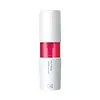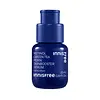What's inside
What's inside
 Key Ingredients
Key Ingredients

 Benefits
Benefits

 Concerns
Concerns

No concerns
 Ingredients Side-by-side
Ingredients Side-by-side

Water
Skin ConditioningButylene Glycol
HumectantPEG/PPG/Polybutylene Glycol-8/5/3 Glycerin
HumectantHydrogenated Retinol
Skin ConditioningTocopherol
AntioxidantCaprylic/Capric Triglyceride
MaskingXanthan Gum
EmulsifyingCarbomer
Emulsion StabilisingPotassium Hydroxide
BufferingPolyglyceryl-10 Laurate
Skin ConditioningBenzophenone-4
UV Absorber1,2-Hexanediol
Skin ConditioningBis-Ethoxydiglycol Cyclohexane 1,4-Dicarboxylate
EmollientPhenoxyethanol
PreservativeLactobacillus Ferment Lysate
Skin ConditioningGlycerin
HumectantPropanediol
SolventWater
Skin ConditioningDipropylene Glycol
HumectantButylene Glycol
HumectantNiacinamide
Smoothing1,2-Hexanediol
Skin ConditioningSqualane
EmollientGlyceryl Polymethacrylate
Dimethyl Isosorbide
SolventMethyl Trimethicone
Skin ConditioningCetearyl Alcohol
EmollientHydroxyethyl Urea
HumectantAmmonium Acryloyldimethyltaurate/Vp Copolymer
Helianthus Annuus Seed Oil
EmollientGlycine Soja Oil
EmollientAllantoin
Skin ConditioningGlyceryl Stearate
EmollientXanthan Gum
EmulsifyingTocopherol
AntioxidantTocopheryl Acetate
AntioxidantPentylene Glycol
Skin ConditioningDipotassium Glycyrrhizate
HumectantSodium Stearoyl Glutamate
CleansingHydrogenated Lecithin
EmulsifyingDaucus Carota Sativa Root Extract
Skin ConditioningHydroxypinacolone Retinoate
Skin ConditioningStearic Acid
CleansingPolyglyceryl-3 Methylglucose Distearate
EmulsifyingSodium Polyacrylate
AbsorbentSodium Metaphosphate
BufferingKojyl Methylenedioxycinnamate
AntioxidantPalmitic Acid
EmollientEthylhexylglycerin
Skin ConditioningAdenosine
Skin ConditioningRetinol
Skin ConditioningSodium Hyaluronate
HumectantHyaluronic Acid
HumectantHydrolyzed Vegetable Protein
Skin ConditioningAchillea Millefolium Extract
CleansingZea Mays Oil
EmulsifyingMyristic Acid
CleansingLauric Acid
CleansingPullulan
Zein
Skin ConditioningCamellia Sinensis Leaf Extract
AntimicrobialPectin
Emulsion StabilisingCitric Acid
BufferingLactobacillus Ferment Lysate, Glycerin, Propanediol, Water, Dipropylene Glycol, Butylene Glycol, Niacinamide, 1,2-Hexanediol, Squalane, Glyceryl Polymethacrylate, Dimethyl Isosorbide, Methyl Trimethicone, Cetearyl Alcohol, Hydroxyethyl Urea, Ammonium Acryloyldimethyltaurate/Vp Copolymer, Helianthus Annuus Seed Oil, Glycine Soja Oil, Allantoin, Glyceryl Stearate, Xanthan Gum, Tocopherol, Tocopheryl Acetate, Pentylene Glycol, Dipotassium Glycyrrhizate, Sodium Stearoyl Glutamate, Hydrogenated Lecithin, Daucus Carota Sativa Root Extract, Hydroxypinacolone Retinoate, Stearic Acid, Polyglyceryl-3 Methylglucose Distearate, Sodium Polyacrylate, Sodium Metaphosphate, Kojyl Methylenedioxycinnamate, Palmitic Acid, Ethylhexylglycerin, Adenosine, Retinol, Sodium Hyaluronate, Hyaluronic Acid, Hydrolyzed Vegetable Protein, Achillea Millefolium Extract, Zea Mays Oil, Myristic Acid, Lauric Acid, Pullulan, Zein, Camellia Sinensis Leaf Extract, Pectin, Citric Acid
Ingredients Explained
These ingredients are found in both products.
Ingredients higher up in an ingredient list are typically present in a larger amount.
1,2-Hexanediol is a synthetic liquid and another multi-functional powerhouse.
It is a:
- Humectant, drawing moisture into the skin
- Emollient, helping to soften skin
- Solvent, dispersing and stabilizing formulas
- Preservative booster, enhancing the antimicrobial activity of other preservatives
Butylene Glycol (or BG) is used within cosmetic products for a few different reasons:
Overall, Butylene Glycol is a safe and well-rounded ingredient that works well with other ingredients.
Though this ingredient works well with most skin types, some people with sensitive skin may experience a reaction such as allergic rashes, closed comedones, or itchiness.
Learn more about Butylene GlycolTocopherol (also known as Vitamin E) is a common antioxidant used to help protect the skin from free-radicals and strengthen the skin barrier. It's also fat soluble - this means our skin is great at absorbing it.
Vitamin E also helps keep your natural skin lipids healthy. Your lipid skin barrier naturally consists of lipids, ceramides, and fatty acids. Vitamin E offers extra protection for your skin’s lipid barrier, keeping your skin healthy and nourished.
Another benefit is a bit of UV protection. Vitamin E helps reduce the damage caused by UVB rays. (It should not replace your sunscreen). Combining it with Vitamin C can decrease sunburned cells and hyperpigmentation after UV exposure.
You might have noticed Vitamin E + C often paired together. This is because it is great at stabilizing Vitamin C. Using the two together helps increase the effectiveness of both ingredients.
There are often claims that Vitamin E can reduce/prevent scarring, but these claims haven't been confirmed by scientific research.
Learn more about TocopherolWater. It's the most common cosmetic ingredient of all. You'll usually see it at the top of ingredient lists, meaning that it makes up the largest part of the product.
So why is it so popular? Water most often acts as a solvent - this means that it helps dissolve other ingredients into the formulation.
You'll also recognize water as that liquid we all need to stay alive. If you see this, drink a glass of water. Stay hydrated!
Learn more about WaterXanthan gum is used as a stabilizer and thickener within cosmetic products. It helps give products a sticky, thick feeling - preventing them from being too runny.
On the technical side of things, xanthan gum is a polysaccharide - a combination consisting of multiple sugar molecules bonded together.
Xanthan gum is a pretty common and great ingredient. It is a natural, non-toxic, non-irritating ingredient that is also commonly used in food products.
Learn more about Xanthan Gum